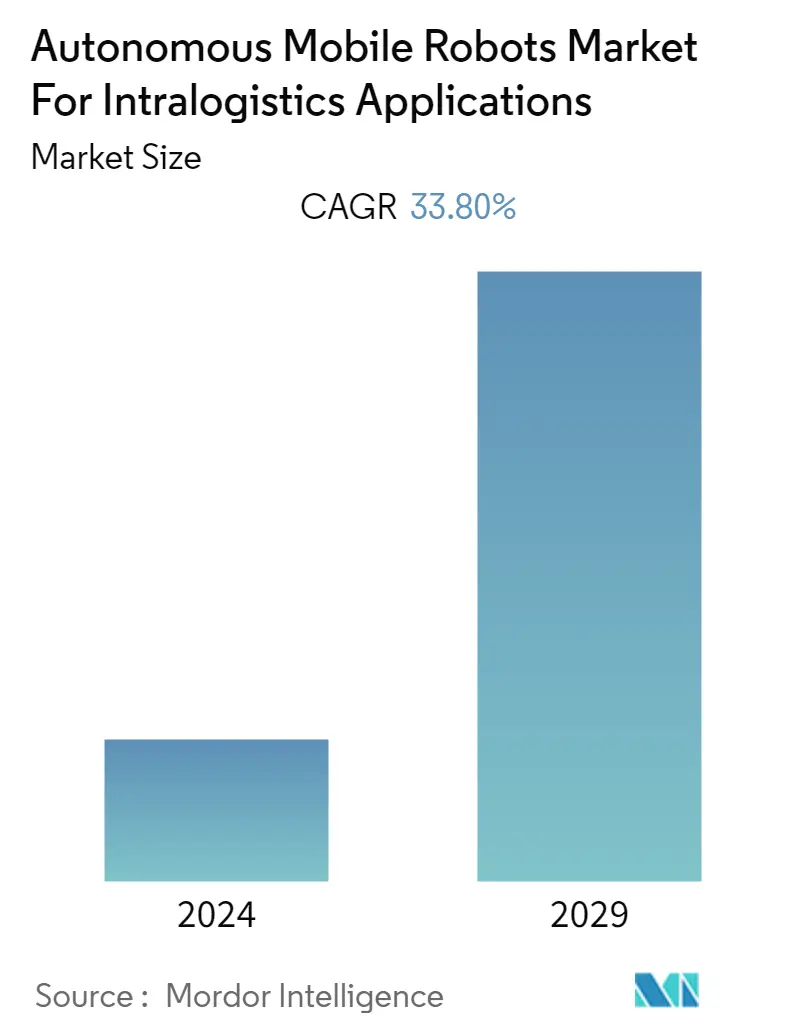Market Size of Autonomous Mobile Robots Industry For Intralogistics Applications

| Study Period | 2019 - 2029 |
| Base Year For Estimation | 2023 |
| CAGR (2024 - 2029) | 33.80 % |
| Fastest Growing Market | Asia Pacific |
| Largest Market | Asia Pacific |
| Market Concentration | Low |
Major Players
*Disclaimer: Major Players sorted in no particular order |
Autonomous Mobile Robots Market Analysis
The Autonomous Mobile Robots Market For Intralogistics Applications Industry is expected to register a CAGR of 33.80% during the forecast period(2024-2029).
- Autonomous robots will become more common in the future supply chain as technology advances, allowing them to operate with more human-like abilities as autonomous robots develop the ability to work around the clock with higher consistent levels of quality and productivity, performing tasks that humans cannot, the advantages for the supply chain of the future are growing.
- The prominent reason for favoring the rampant growth of autonomous mobile robots in the global market is their unlimited movement by their physical size due to their mobility, which is largely opposed by industrial robots. As a result, autonomous mobile robots are capable of operating in a large workspace and exploring unknown environments and, therefore, are significantly performing tasks wherever needed. Owing to the need to operate in unknown and uncertain environments, autonomous mobile robots are incorporated with much higher-level intelligence than traditional industrial robots.
- The combination of technologies such as artificial intelligence, automation, the Internet of Things, computing power, and robotics enables the building of a new generation of smart factories. Robotics and automation have changed significantly over the past few years. In the continuously growing range of industries such as electronics, automotive, food, metalworking, and material handling, increasing investment in advanced automation creates ample opportunities for mobile robots.
- Notably, in the manufacturing sector, autonomous mobile robots have been gaining significant momentum as they address the demand for flexible material handling, the need for robots to operate on large structures, and the requirement for rapid reconfiguration of work areas. As per the material handling institute, two roadmaps provide predictions for future mobile robot systems.
- However, the high initial cost of mobile robots is a common concern for many organizations considering their adoption. Despite the high initial cost, mobile robots can provide a significant return on investment (ROI) over time, particularly in environments where they can increase efficiency, reduce labor costs, and improve safety. As the costs of AMRs continue to decrease and their abilities improve, it is important to consider the potential hidden expenses that may arise from their implementation. In addition to the initial setup, deployment, and reconfiguration efforts, other costs come under, particularly if the robot is not user-friendly. This poses a challenge to the growth of the market.
- The COVID-19 pandemic had a significant impact on the autonomous mobile market due to the shortage of workforce, the shutdown of manufacturing facilities to restrict the spread of the virus and nationwide lockdowns. The COVID-19 pandemic further boosted the market with the high demand for robotics disinfection solutions, robotic logistics solutions in factories and warehouses, or robots for home delivery.
Autonomous Mobile Robots Industry Segmentation
Autonomous robots are intelligent machines that can do real-world tasks without the intervention of a human. Autonomous mobile robots (AMRs) can comprehend and navigate their surroundings without direct human supervision. An autonomous mobile robot navigates utilizing maps generated on-site by its software or facility designs that have been pre-loaded. An autonomous mobile robot uses technology, such as LiDAR sensors and simultaneous localization and mapping (SLAM), to determine the best path between waypoints.
The autonomous mobile robots market for intralogistics applications market is segmented by form factor (tow/tractor/tug, order picking/fulfillment, and load carrying), environment of operation (manufacturing and non-manufacturing), and geography (United States, Europe, Asia Pacific (Excluding China and India), China, India, and the Rest of World). The market sizes and forecasts are provided in terms of value (USD) for all the above segments.
| By Form Factor | |
| Tow/Tractor/Tug | |
| Order Picking/Fulfillment (Unit Load/Deck Load/Assembly Line) | |
| Load Carrying (Forklifts/Counterbalance) |
| By Environment of Operation | |
| Manufacturing (Automotive, Electrical & Electronics, Food & Beverage, Chemical & Pharmaceuticals) | |
| Non-Manufacturing (Logistics Centers/Distribution Centers/Warehouses) |
| By Geography | |
| United States | |
| Europe | |
| Asia Pacific (Excluding China and India) | |
| China | |
| India | |
| Rest of the World |
Autonomous Mobile Robots Market For Intralogistics Applications Size Summary
The autonomous mobile robots (AMRs) market for intralogistics applications is poised for substantial growth, driven by advancements in technology and the increasing need for automation across various industries. These robots are becoming integral to future supply chains, offering capabilities that enhance productivity and efficiency by operating continuously with high precision. Unlike traditional industrial robots, AMRs benefit from their mobility, allowing them to navigate large and unpredictable environments, which is crucial for sectors like manufacturing, automotive, and e-commerce. The integration of technologies such as artificial intelligence, the Internet of Things, and advanced robotics is facilitating the development of smart factories, where AMRs play a pivotal role in optimizing operations and reducing costs. Despite the initial high investment required, the long-term return on investment is significant, particularly in environments where they can streamline processes and improve safety.
The Asia-Pacific region is emerging as a dominant force in the AMR market, fueled by rapid industrialization and the strategic adoption of automation technologies. Countries like China and India are leading this growth, with significant investments in manufacturing and e-commerce sectors. The region's focus on enhancing supply chain efficiency and the growing demand for robotics in warehousing and logistics are key drivers. Notable developments include the introduction of innovative solutions like autonomous case-handling systems and mobile charging robots, which are set to revolutionize warehouse management and support the expanding electric vehicle infrastructure. The market is characterized by intense competition among key players, with strategic partnerships and technological advancements driving further expansion and market share growth.
Autonomous Mobile Robots Market For Intralogistics Applications Market Size - Table of Contents
-
1. MARKET INSIGHTS
-
1.1 Market Overview - Current Scenario of AMR Robotics
-
1.2 Industry Attractiveness - Porter's Five Forces Analysis
-
1.2.1 Bargaining Power of Suppliers
-
1.2.2 Bargaining Power of Buyer/Consumers
-
1.2.3 Threat of New Entrants
-
1.2.4 Intensity of Competitive Rivalry
-
1.2.5 Threat of Substitutes
-
-
1.3 Industry Value Chain Analysis
-
1.4 Impact of Macro Trends
-
1.5 Patent Analysis
-
1.6 Regulatory Landscape
-
1.7 ROI Analysis/Payback Analysis
-
-
2. MARKET SEGMENTATION
-
2.1 By Form Factor
-
2.1.1 Tow/Tractor/Tug
-
2.1.2 Order Picking/Fulfillment (Unit Load/Deck Load/Assembly Line)
-
2.1.3 Load Carrying (Forklifts/Counterbalance)
-
-
2.2 By Environment of Operation
-
2.2.1 Manufacturing (Automotive, Electrical & Electronics, Food & Beverage, Chemical & Pharmaceuticals)
-
2.2.2 Non-Manufacturing (Logistics Centers/Distribution Centers/Warehouses)
-
-
2.3 By Geography
-
2.3.1 United States
-
2.3.2 Europe
-
2.3.3 Asia Pacific (Excluding China and India)
-
2.3.4 China
-
2.3.5 India
-
2.3.6 Rest of the World
-
-
Autonomous Mobile Robots Market For Intralogistics Applications Market Size FAQs
What is the current Autonomous Mobile Robots Market For Intralogistics Applications Industry size?
The Autonomous Mobile Robots Market For Intralogistics Applications Industry is projected to register a CAGR of 33.80% during the forecast period (2024-2029)
Who are the key players in Autonomous Mobile Robots Market For Intralogistics Applications Industry?
ABB ltd, Aethon, Addverb Technologies Limited, 6 River Systems, LLC and Agilox are the major companies operating in the Autonomous Mobile Robots Market For Intralogistics Applications Industry.
Autonomous Mobile Robots Market For Intralogistics Applications Report Snapshots
- Autonomous Mobile Robots Market For Intralogistics Applications Market Size
- Autonomous Mobile Robots Market For Intralogistics Applications Market Share
- Autonomous Mobile Robots Market For Intralogistics Applications Market Trends
- Autonomous Mobile Robots Market For Intralogistics Applications Companies

